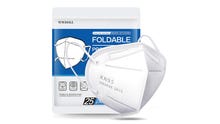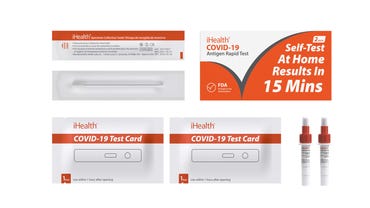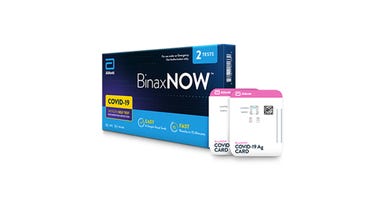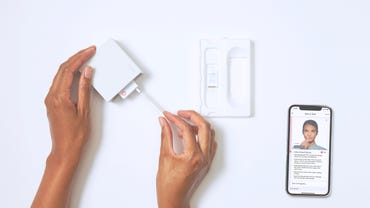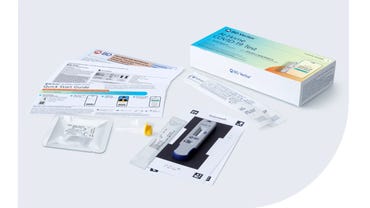Covid testing: How to get free at-home rapid test kits
We're almost two years into the pandemic, and it's abundantly clear that COVID-19 isn't going away anytime soon. Over the last month or two, there's been a renewed focus on rapid testing at home. For example, as of Jan 15, insurance companies are now required to cover the cost of at-home rapid tests by reimbursing subscribers for up to 8 tests per month per covered family member.
On Jan 18, the White House started distributing 1 billion free rapid tests through a dedicated website, but it can take almost two weeks before you'll receive the free tests. The program was originally slated to open on Jan. 19, but it went live a day early.
If you need tests sooner than that, be it for peace of mind before visiting a family member or because you suspect you or a family member is sick, here are some tests I've personally used and the details you need to know about each one. Most importantly, if you have private insurance — make sure you're saving your receipts to file claims with your insurance company. Each test will give you test results and hopefully peace of mind in 20 minutes or less. Three of the tests mentioned below are affordable and widely-available rapid antigen tests, while the Cue Health test is more expensive, but the results can be used to clear you for travel or to meet work and school requirements.
There's currently a high demand for all tests in the US as the omicron variant continues to spread, and we all plan on spending time with our families. Be patient but persistent when shopping for tests. And, again, if all else fails, go to a nearby testing center.
The FDA currently approves the options listed below under an Emergency Use Authorization. I've linked to the available FDA report for each test's accuracy when available.
Affordable rapid tests for home or work
Cost: $17.98 | Number of tests included: 2 | Time for results: 15 minutes | Positive Test Accuracy: 94.3% | Negative Test Accuracy: 98.1% |
iHealth recently started selling its at-home antigen rapid tests in a pack of two for $17.98. According to the FDA, the iHealth tests were 94.3% accurate in detecting a positive test result and 98.1% accurate when detecting negative test results.
Each test includes the nasal swab, an extraction tube, and the test card. The card has two possible lines on it. The C line will always turn purple to show it's a valid test. The T line will remain absent if it's a negative result, or turn purple — matching the C line — if the test is positive.
You can download the iHealth COVID-19 Test app on your phone for detailed instructions and to store test results for yourself, family members, or colleagues.
I've given or taken a few of these tests now and the process is easy, but a little confusing the first time due to how you transfer the sample from the swab to the tube. But once you get comfortable with the process, you'll have no issues.
A commonly available rapid test
Cost: $23.99 | Number of tests included: 2 | Time for results: 15 minutes | Positive Test Accuracy: 91.7% | Negative Test Accuracy: 100% |
You may have heard of or seen the BinaxNOW test on store shelves. It's $23.99 for a pack of two tests and can commonly be found at Walgreens, CVS, RiteAid, and Walmart. Availability will vary depending on where you live, so I recommend checking Abott's website for stock updates.
Inside each box are two instruction sheets, two nasal swabs, two solution droppers, and two test cards. Each card has two lines on it, one Control and one Sample. A purple line next to Control will always show up, while the Sample line is only visible if the test is positive.
I've administered and taken a handful of these tests, and they're incredibly simple. I prefer this test process over the iHealth test kit simply because you don't have to worry about properly transferring the sample. You only have to place the swab inside the card, twirl it a few times. However, while affordable, the price of this kit can add a layer of hesitation for frequent testing.
The companion app will walk you through the testing process and even record your results for you, giving you quick access to the last time you took a test and the accompanying results.
According to the FDA, BinaxNOW's test results showed 91.7% accuracy for positive test samples and 100% accuracy for negative results.
Pricey but more advanced and reliable
Cost: $195 | Number of tests included: 3 | Time for results: 20 minutes | Positive Test Accuracy: 97.8% | Negative Test Accuracy: 97.8% |
Cue Health's COVID-19 Test is by far the most expensive test on this list. Each test cartridge is $65 and sold in packs of three or ten. In order to use the cartridges, you'll need the $249 Cue Reader to process, analyze and transmit the results to your phone. You can buy a pack of 10 cartridges and the Cue Reader for $954.05, or a kit with a Cue Reader and 3 tests for $444.
Why so expensive? Unlike the iHealth and BinaxNOW test, Cue Health's test isn't a rapid antigen test. The test uses “nucleic acid amplification”, which is equivalent to a PCR test. PCR tests are the tests that you get at a doctor's office or a community testing center and can take several hours or days to get your results.
Cue's system gives you results in about 20 minutes.
An independent study by the Mayo Clinic found the Cue COVID test to be 97.8% accurate. Here's the FDA report, as well.
Cue offers two different subscription plans for those who don't want to spend a lot of money upfront for a Cue test system. For $39.99 per month, the Cue+ Essential plan gives you 10 tests per year, a $100 discount on the Cue Reader, and 24/7 access in the Cue Health app to primary care doctors.
For $74.99 a month, Cue+ Complete provides 20 tests per year, the same $100 discount on the Cue Reader, and — most importantly — the ability to take a supervised test at home. By taking a supervised test, your test results will be CDC-compliant and can be used to return to work, school, or to travel.
In other words, instead of going to the doctor to get a PCR test and waiting a couple of days for the results before you can go back to work, you can take a test at home and have the results in 20 minutes.
Cost: $33.75 | Number of tests included: 2 | Time for results: 15 minutes | Positive Test Accuracy: 84.6% | Negative Test Accuracy: 99.8% |
My wife and I just finished taking two of these tests, which were sent in the same kit. This test works a little differently than the others I've used; instead of reading the results on the test stick yourself, you have to use the smartphone app to scan the stick to receive the results.
Performing the test is done via a nasal swab, which is then dipped and swirled into a collection tube that's already filled with the test liquid. You then place three drops from the tube onto the test stick, and wait 15 minutes. Once the time is up, you hold up your smartphone's camera and scan the stick. A minute later, you're given your test results.
Each step of the process has clear instructions via a video that's built into the app itself. You can't take the test without using the app, as there's no way to read the results otherwise. The FDA's test results can be found here, but the short version is this test is in the same ballpark as the rest of the EUA test kits listed here and found on store shelves.
Also worth considering
I've had some trouble finding the BinaxNOW test in stock at my local Walgreen's, so if you run into issues finding a test for that or any of the other options mentioned above, here are some alternatives that I haven't personally used but have positive reviews:
COVID-19 Test FAQ
How do I get the free tests President Biden announced?
Yes. As mentioned earlier, there are two different programs. As of Jan. 15, private insurance companies are required to cover the cost of up to four tests per family member per month. That equates to a family of four receiving up to 32 tests per month. However, you'll likely need to pay for the tests first, then file for reimbursement through your insurance company. I received an email from my insurance provider with instructions about filing claims for reimbursement. Check with your insurance provider for similar instructions or with any questions you have.
The second program offers four free tests to each household started on Jan. 18. You can place an order for your allotment of free tests — there will be a total of 1 billion tests available in total — by visiting the website Covidtests.gov and filling out the “Order Free At-Home Tests” form with your contact information and shipping address. If that site isn't loading due to demand, can skip it and just use the United States Postal Service's order form here. Enter your email address if you want to receive updates on the shipping status.
If you're having trouble getting the form to accept your apartment number in the stand-alone field, try entering your entire street address, including your apartment number in the same field.
Here's some more information about the kits according to the website:
- Every test kit includes rapid antigen at-home tests, not PCR (polymerase chain reaction)
- The tests can be taken anywhere
- You can expect results within 30 minutes (no lab drop-off required)
- Tests work whether or not you have COVID-19 symptoms and/or up to date with your vaccines
Test kits will ship via USPS and will arrive in 7-12 days, so it's a good idea to order as soon as possible. Don't wait until you have symptoms and need to test.
What's the difference between an antigen test and PCR test?
A PCR (polymerase chain reaction) test is the most accurate type of test for COVID-19. The results from a PCR test are often what's required for work, school or travel. Depending on where you take the test, the results can take several days to come back. A PCR test looks for the genetic material of the virus.
Rapid antigen tests often produce results in 15 minutes but aren't as accurate as a PCR test. The antigen test looks for the proteins of the virus. Antigen tests aren't usually accepted for travel or admission to work or school.
Which test is right for me?
Whichever test(s) are currently in stock and that you're willing to pay for, at least until you can get reimbursed. The more proactive we all are with testing when we feel sick or after being around a large crowd, the better off we all are.

